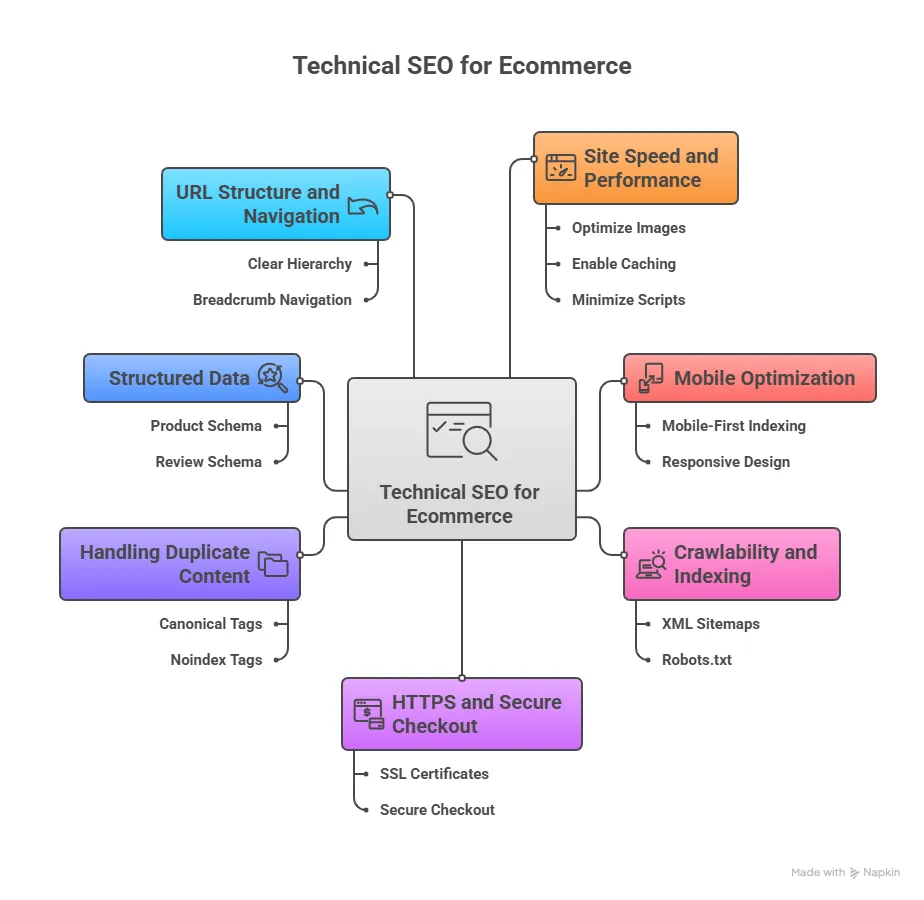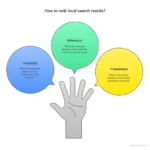Ecommerce SEO is the process of optimizing an online store to rank higher in search engine results. Its main goal is to increase organic traffic and boost sales by making products and categories easy for both users and search engines to find.
Unlike traditional SEO, Ecommerce SEO focuses not just on informational pages, but on product pages, category pages, and transactional intent. Every page on your store has the potential to attract customers searching for specific products.
Search engines use signals like product descriptions, titles, pricing, reviews, and structured data to determine relevance. A well-optimized store can appear in organic results, rich snippets, and even Google Shopping.
Ecommerce SEO also improves user experience by making navigation intuitive, speeding up page load times, and ensuring mobile-friendliness. This combination of visibility and usability helps increase traffic, conversions, and revenue for online stores.
In the next section, we’ll explore how search engines understand Ecommerce websites using entities, structured data, and semantic signals.
How Search Engines Understand Ecommerce Websites
Search engines use advanced algorithms to understand Ecommerce websites, focusing on products, categories, and user intent rather than just keywords. Proper optimization ensures your store is visible to the right audience at the right time.
1. Product and Category Entities
Each product and category is treated as an entity by Google. This helps the search engine understand:
- What the product is
- Its features and specifications
- Its category and related products
Using clear, unique product names and descriptions helps Google correctly classify your items.
2. Structured Data and Schema Markup
Structured data communicates detailed information to search engines. For Ecommerce sites, common schemas include:
- Product Schema: Name, description, price, availability, brand
- Review Schema: Customer ratings and testimonials
- Offer Schema: Discounts, sales, and promotions
Example:
<script type="application/ld+json">
{
"@context": "https://schema.org",
"@type": "Product",
"name": "Wireless Bluetooth Headphones",
"image": "https://example.com/headphones.jpg",
"description": "High-quality wireless Bluetooth headphones with noise cancellation.",
"brand": "AudioBrand",
"sku": "AB12345",
"offers": {
"@type": "Offer",
"priceCurrency": "INR",
"price": "2999",
"availability": "https://schema.org/InStock"
},
"aggregateRating": {
"@type": "AggregateRating",
"ratingValue": "4.7",
"reviewCount": "256"
}
}
</script>
3. Semantic Understanding
Google interprets the context and meaning of product descriptions, reviews, and category pages. It can recognize synonyms, related products, and buyer intent, which improves search relevance.
- Example: Searching for “running shoes” may also surface pages for “jogging sneakers” if your content is semantically optimized.
4. Internal Linking
Logical internal linking between categories, subcategories, and products helps Google crawl your site efficiently.
- Links also signal relationships between products and categories, strengthening entity understanding.
By combining entities, structured data, semantic SEO, and proper internal linking, search engines can accurately index your Ecommerce website and show your products in relevant searches.
Keyword Research for Ecommerce SEO
Keyword research is the foundation of Ecommerce SEO. The right keywords help your products and categories appear in searches with high purchase intent, driving traffic that converts into sales.
1. Focus on Transactional Keywords
Transactional keywords indicate a strong buying intent. Examples include:
- “Buy wireless headphones online”
- “Best SEO course for beginners”
- “Affordable gaming laptop in Kochi”
These keywords attract users who are ready to make a purchase.
2. Use Product and Category Keywords
- Product Keywords: Specific to individual items (e.g., “iPhone 15 Pro Max 256GB”).
- Category Keywords: Broader terms for a group of products (e.g., “smartphones under 50k”).
Balancing both helps target users at different stages of the buying journey.
3. Long-Tail Keywords
Long-tail keywords are longer, more specific phrases. They often have lower competition and higher conversion rates.
- Example: Instead of “headphones,” target “wireless noise-cancelling headphones for travel.”
4. Analyze Competitors
Check which keywords competitors rank for and identify gaps in your store’s content. Tools like:
- Ahrefs
- SEMrush
- Ubersuggest
- Google Keyword Planner
5. Consider Seasonal and Trending Keywords
- Track trends for seasonal products using Google Trends.
- Update product pages with trending keywords to attract timely traffic.
6. Optimize for Buyer Intent
Classify keywords by intent:
- Informational: “What are the best running shoes?”
- Transactional: “Buy running shoes online”
- Navigational: “Nike store near me”
Focus mostly on transactional keywords for product pages and informational keywords for blog or guide content to support Ecommerce SEO.
On-Page SEO for Product and Category Pages
On-page SEO ensures your products and categories are easily discoverable by both search engines and users. Proper optimization improves rankings, click-through rates, and conversions.
1. Optimize Titles and Meta Descriptions
- Include primary keywords and product names.
- Highlight unique features or offers to attract clicks.
Example:
<title>Wireless Noise-Cancelling Headphones | AudioBrand</title>
<meta name="description" content="Buy high-quality wireless noise-cancelling headphones with long battery life. Free shipping and easy returns available.">
2. Unique Product Descriptions
- Avoid copying manufacturer descriptions.
- Highlight benefits, features, and use cases.
- Incorporate keywords naturally without stuffing.
3. Category Page Optimization
- Use clear headings and subcategories.
- Include short, keyword-rich descriptions for each category.
- Link to relevant products and related categories.
4. Image Optimization
- Use descriptive alt text with keywords (e.g., “Wireless Noise-Cancelling Headphones”).
- Compress images for faster loading.
- Include multiple high-quality images per product.
5. Structured Data / Schema
- Add Product, Review, Offer, and AggregateRating schema.
- Helps Google show rich snippets like stars, price, and availability in search results.
6. URL Structure
- Keep URLs short, descriptive, and keyword-rich.
Example:www.example.com/headphones/wireless-noise-cancelling
7. Internal Linking
- Link products to related items and popular categories.
- Improves navigation, distributes link authority, and helps Google understand relationships.
8. Mobile Optimization
- Ensure product pages are responsive and load quickly.
- Add click-to-call buttons if relevant for service-based products.
Technical SEO for Ecommerce
Technical SEO ensures that your Ecommerce website is crawlable, fast, and user-friendly, allowing search engines to index your products properly and users to have a smooth experience.
1. Site Speed and Performance
- Optimize images, enable caching, and minimize scripts.
- Use Content Delivery Networks (CDN) for faster global access.
- Faster sites improve rankings and reduce bounce rates.
2. Mobile Optimization
- Mobile-first indexing means Google primarily looks at your mobile version.
- Ensure all pages are responsive, buttons are clickable, and forms are easy to use.
3. Crawlability and Indexing
- Create XML sitemaps for products and categories.
- Use robots.txt to prevent indexing of duplicate or low-value pages.
- Implement canonical URLs for product variants to avoid duplicate content.
4. HTTPS and Secure Checkout
- Use SSL certificates to secure user data.
- Secure sites gain trust from Google and customers.
5. Handling Duplicate Content
- Ecommerce sites often have duplicates due to product variations or sorting/filtering options.
- Use canonical tags, noindex tags, or parameter handling in GSC.
6. Structured Data
- Reinforce product information with Product, Review, Offer, and Breadcrumb schema.
- Helps search engines display rich snippets, improving CTR.
7. URL Structure and Navigation
- Maintain a clear hierarchy: Homepage → Category → Subcategory → Product.
- Use breadcrumb navigation to enhance UX and SEO.

Proper technical SEO ensures that all your products and categories are indexed correctly, pages load quickly, and users can easily navigate, boosting both traffic and conversions.
Internal Linking and Site Structure
A clear site structure and internal linking strategy help both users and search engines navigate your Ecommerce store efficiently. They also distribute authority across important pages, improving rankings.
1. Hierarchical Site Structure
- Organize your store in a logical hierarchy:
Homepage → Category → Subcategory → Product - Keeps navigation intuitive and improves crawlability.
2. Breadcrumb Navigation
- Add breadcrumbs on all product and category pages.
- Helps users track their location and Google understand page relationships.
Example:Home > Electronics > Headphones > Wireless Noise-Cancelling
3. Linking Related Products
- Link to similar or complementary products to improve UX and reduce bounce rates.
- Example: On a laptop page, link to laptop bags, accessories, or extended warranties.
4. Optimizing Anchor Text
- Use descriptive, keyword-rich anchor text for internal links.
- Avoid generic phrases like “click here.”
5. Footer and Menu Links
- Include key categories in your footer for better crawlability.
- Keep menus simple, highlighting top-selling or seasonal categories.
6. XML Sitemaps
- Include all product and category pages in your sitemap.
- Submit to Google Search Console to help indexing.
A strong internal linking and site structure improves user experience, crawl efficiency, and page authority, making it easier for search engines to rank your products and categories.
User-Generated Content and Reviews
User-generated content (UGC), like reviews, ratings, and Q&A, is a powerful component of Ecommerce SEO. It helps search engines understand your products better and builds trust with potential buyers.
1. Importance of Reviews
- Reviews provide fresh content for search engines, which can improve ranking signals.
- Positive reviews increase click-through rates and conversion rates.
2. Encourage Authentic Reviews
- Request reviews via email, after purchase, or through your website.
- Offer incentives carefully without violating guidelines.
- Ensure reviews reflect genuine customer experiences.
3. Use Q&A Sections
- Allow users to ask and answer questions on product pages.
- Helps Google understand common queries and improves semantic relevance.
4. Leverage Ratings in Rich Snippets
- Display ratings and star reviews in search results using AggregateRating schema.
- Makes your product listings more attractive and increases CTR.
5. Monitor and Manage Reviews
- Respond to reviews promptly, addressing both positive and negative feedback.
- Monitor review platforms like Google, Amazon, or marketplace listings.
By leveraging user-generated content, Ecommerce websites not only enhance SEO performance but also build trust and authority in the eyes of potential buyers.
Off-Page SEO for Ecommerce
Off-page SEO helps your Ecommerce store build authority, trust, and backlinks, which improve rankings and visibility in search results.
1. Build Quality Backlinks
- Obtain links from industry blogs, news sites, or authoritative websites.
- Collaborate with niche influencers to feature your products.
- Guest posting on relevant sites can drive both traffic and authority.
2. Social Media Presence
- Share products, offers, and content on platforms like Facebook, Instagram, and LinkedIn.
- Social mentions indirectly support brand authority and visibility.
3. Influencer Collaborations
- Partner with micro or macro influencers for product reviews or promotions.
- Increases traffic, engagement, and potential backlinks.
4. User Mentions and Brand Signals
- Even unlinked mentions of your store or products help Google recognize your brand as an entity.
- Encourage press mentions, local features, and media coverage.
5. Community and Forum Engagement
- Participate in relevant forums or communities like Quora, Reddit, or niche groups.
- Provide value and link to your store naturally when appropriate.
Off-page SEO complements your on-page and technical efforts, increasing your store’s credibility, improving rankings, and driving more qualified traffic.
Monitoring and Measuring Ecommerce SEO Performance
Tracking your Ecommerce SEO performance is crucial to understand what’s working and identify areas for improvement. Using the right tools and metrics ensures that your optimization efforts translate into traffic and sales.
1. Google Search Console (GSC)
- Track impressions, clicks, and queries for product and category pages.
- Identify pages with high impressions but low clicks to optimize titles and meta descriptions.
2. Google Analytics 4 (GA4)
- Monitor organic traffic and user behavior.
- Track conversions such as purchases, add-to-cart actions, or newsletter sign-ups.
- Analyze geographic, device, and referral data to optimize targeting.
3. Ecommerce-Specific Tools
- Ahrefs, SEMrush, Screaming Frog for keyword tracking, backlink analysis, and site audits.
- Hotjar or Crazy Egg for heatmaps to analyze user interactions on product pages.
4. Key Metrics to Track
- Organic Traffic: Visits from search engines.
- Conversion Rate: Percentage of visitors completing purchases.
- Keyword Rankings: Position of product and category keywords.
- Click-Through Rate (CTR): Percentage of searchers clicking your listing.
- Revenue and ROI: Direct impact of SEO efforts on sales.
5. Regular Audits
- Perform technical audits to identify crawl errors, broken links, or duplicate content.
- Review product and category pages for SEO compliance and updates.
Monitoring SEO performance ensures you can adjust strategies, optimize underperforming pages, and maximize revenue from organic traffic.
Future Trends in Ecommerce SEO
Ecommerce SEO is constantly evolving, driven by AI, changing search behaviors, and new search features. Staying ahead of trends ensures your online store maintains visibility and competitiveness.
1. AI-Powered Search and Semantic Understanding
- Search engines increasingly use AI to understand context, intent, and entities rather than just keywords.
- Ecommerce sites optimized with semantic SEO and entity-based strategies will rank higher.
- Example: Google can link related products and categories even if exact keywords aren’t used.
2. Voice and Visual Search
- Voice search queries are becoming more conversational, often asking questions like “Where can I buy wireless headphones near me?”
- Visual search allows users to find products using images, creating new opportunities for optimization.
3. Rich Snippets and Schema Evolution
- Enhanced SERP features like product stars, pricing, availability, and FAQs attract more clicks.
- Keeping structured data up-to-date ensures maximum visibility in rich results.
4. Personalization and AI Recommendations
- AI helps deliver personalized search results and product recommendations based on user behavior.
- Optimized product pages and content increase the chances of appearing in personalized suggestions.
5. Mobile-First and Page Experience
- Mobile-first indexing will continue to dominate.
- Fast loading, responsive designs, and smooth UX are critical for both ranking and conversions.
6. Integration with Other Platforms
- Google Shopping, social commerce, and marketplaces are tightly integrated with search results.
- Accurate product data and entity signals across platforms will drive better visibility.
The future of Ecommerce SEO focuses on combining technical excellence, semantic understanding, structured data, and user-focused content. Businesses that embrace AI-driven trends and optimize for rich search experiences will dominate organic search traffic and conversions.

